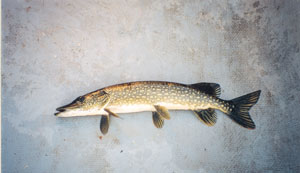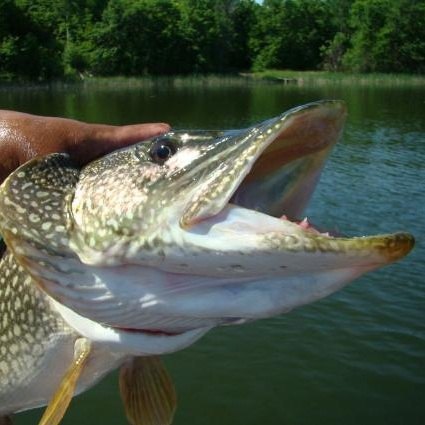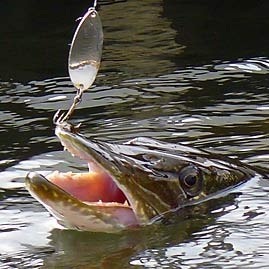Information & facts
Northern Pike

Latin Name
Esox lucius
Group Name
Freshwater
Habitat
Northern pike are a freshwater fish occurring in countless lakes, rivers and streams in both North America and Eurasia. In Canada, their range begins in Quebec and extends through Ontario (including the Great Lakes) and the Prairie provinces to British Columbia, and north to Yukon and the Northwest Territories. Pike are also common throughout the United States. They are aggressive, territorial predators that like heavily vegetated areas of the water from which they can ambush prey.
Species Description
Northern pike have a long, streamlined body and a flat, pointed snout that resembles a duck's bill. Their mouth is large and filled with sharp teeth. Pike have a dorsal fin quite far down their length, close to their tail fin and mirrored by their anal fin. On top, their colour ranges from brown or olive-brown to bright green, with white blotches along their flanks. On their underside they are white. Pike average about 50-75 centimetres in length and 0.9-2.3 kilograms in weight, though northern pike weighing 6.8-9.0 kilograms are not uncommon.
 Northern pike are a carnivorous fish that is native to the northern hemisphere. They live in freshwater and brackish water. They can be found in Europe, North America and Russia, but they have also been introduced in other areas. Juvenile northern pike will feed on daphnia and other small invertebrates. As they grow, they will also feed on gammaruses and asselluses. Once they reach about 3″ to 5″ they’ll start going after small fish. As they grow larger they will mainly feed on other types of fish, including their own species. Northern pike do not school but will follow schools of other fish (such as Roach fish) during the winter months.
Northern pike are a carnivorous fish that is native to the northern hemisphere. They live in freshwater and brackish water. They can be found in Europe, North America and Russia, but they have also been introduced in other areas. Juvenile northern pike will feed on daphnia and other small invertebrates. As they grow, they will also feed on gammaruses and asselluses. Once they reach about 3″ to 5″ they’ll start going after small fish. As they grow larger they will mainly feed on other types of fish, including their own species. Northern pike do not school but will follow schools of other fish (such as Roach fish) during the winter months.
 The northern pike’s habitat will usually be a large body lake or sluggish stream. They like cold water that is clear and will hang around weed beds and rocks. They like these type of structures because they are ambush predators. Northern pike will remain completely still for extended periods of time until suitable prey passes by and then they will strike with amazing acceleration. They can adapt to almost any body of water, both fresh and brackish, as long as it has a bait fish population. However, to sustain a population there needs to be locations in the body of water where northern pike can spawn. Northern pike are a very popular game fish and great care should be taken when removing a hook since they have powerful jaws with very sharp teeth.
The northern pike’s habitat will usually be a large body lake or sluggish stream. They like cold water that is clear and will hang around weed beds and rocks. They like these type of structures because they are ambush predators. Northern pike will remain completely still for extended periods of time until suitable prey passes by and then they will strike with amazing acceleration. They can adapt to almost any body of water, both fresh and brackish, as long as it has a bait fish population. However, to sustain a population there needs to be locations in the body of water where northern pike can spawn. Northern pike are a very popular game fish and great care should be taken when removing a hook since they have powerful jaws with very sharp teeth.
How to fish for Northern Pike
Northern Pike refers shallow, weedy, clear waters in lakes and marshes, but also inhabits slow streams and rivers. After ice-off, they move further into shallows and marshes to spawn, retreating to deep cool waters in summer. Northern Pike prefer a temperature of 50F to 60F, and may stop feeding if water becomes to warm. Northern Pike are voracious and opportunistic predators consuming three to four times their weight each year. They ambush prey from weedy cover, seizing fish with their needlelike teeth. The Northern Pike will attack large prey, often a third their own length. Northern Pike feed mostly on other fish such as suckers, shiners, chubs, Cisco, Yellow Perch, and other Pike. Northern Pike will also feed on frogs, crayfish, mice, and ducklings.
For Northern Pike a medium or medium-heavy action rod that is 6 to 7 feet long and matched up with a baitcasting reel spooled with 15 to 20 lb test of braided dacron mainline is a good tackle set up. At the end of your mainline tie on a heavy snap swivel and to the snap swivel attach an 18 inch 40 lb test wire leader. A steel leader is essential because Northern Pike have razor sharp teeth that can cut or fray the line while you are fighting the fish. Northern Pike hit lures hard so keep your drag on the light side.
When fishing for Northern Pike larger lures are better, the Northern Pike is an aggressive feeder that will grab larger lures. By large I mean 3 to 4 inches long for most lures and for spoons and plugs 3 to 6 inches long. The color choice for your lures can vary from area to area but consistent colors that seem to work are red and white, red and silver, yellow, yellow and black, gray and white, yellow and green, and brown and white.
When fishing with spoons or plugs along the edge of weed beds a medium retrieval speed is best, you want to mimic a baitfish cruising the weed edge looking for dinner. Your spoons and plugs should have that distinctive swimming wiggle. Spinners should be fished with a slow and even pace with just enough speed for the spinner blade to rotate. Top water lures should be fished over the weed beds right on the surface or just below. Fish them with a quick and erratic retrieval. Fish these lures as if they were a mouse or frog trying to get across the lake before they are noticed. The methods above are a guideline or a starting point. If the pike aren't biting then mix up your retrieval methods, lures, and colors.
A variety of lures that have been constant producers of Northern Pike are a dressed #5 Mepps spinner, Mepps Musky Killer, Magnum Musky Killer, Giant Killer, Mepps Marabou or Musky Marabou, Dardevle Spoons, Crank Baits, Jerk Baits, Spinner Baits Large Mepps Bucktails, Rattle Baits, Spooks Jitter Bugs, Jointed Rapalas, Ziggy Lures, Willy Lures, Wiley Lures, Lucky Strike Wooden Muskie Plugs, Hedon Muskie Plugs, and Bucktails in colors mentioned above.
Northern Pike Fishing Tips, Tricks and Tactics
- Playing Games with Bait – Northern pike are notorious for playing with angler’s bait. They will sometimes hit your bait and simply let go without actually running with it. You don’t want to try and set the hook until the fish actually tries to run with the bait. If you lose a northern pike then don’t reel in right away, go slowly, the fish might actually strike it again.
- You Need the Right Size Bait – If you’re looking to catch a monster northern pike then you’ll need something bigger than the average tackle store minnow. Large northern pike won’t waste the time or energy to chase small bait fish, so you’ll want to use bait that is between 6 to 8 inches. Since most bait stores won’t carry these you’ll want to consider catching your own bait, you’ll even save a few bucks.
- Best Type of Lures – The best type of lures for northern pike are dardevles and jerk bait because they replicate the type of bait fish that can be found naturally in the lake you’re fishing in. For specific brands, we recommend Eppinger’s Original Dardevle Spoons and Rapala’s Husky Jerk Bait. Large spoons can also be very effective, especially if you use a quality brand such as the Cotton Cordell Spoon Lure.
- Fish the Weeds – Small to medium northern pike are usually found near heavily weeded areas. This is because they are ambush predators and like to ambush their prey. The larger northern pike will be where they can hide in deep water to attack larger types of fish such as walleye or large mouth bass.
Northern Pike Facts and Stats
I’ve put the below facts together for those anglers who just want to know the basics about northern pike. Some of the below information may or may not be an average, while others might be the top of the bell curve and only represent less than 5% of the world’s northern pike population. These facts were put together using references of the highest credibility, you may find stats that differ from other websites, but we feel that my stats most accurately represent northern pike.
- Scientific Name: Northern Pike (exos lucius)
- Nickname(s): Northerns, pike
- Lifespan: Up to 24 years
- Length: Up to 3′, but on average much smaller
- Weight: Up to 20 pounds, but on average much smaller
- Range: The entire northern hemisphere, mostly Europe, Russia and North America
More Resources on Northern Pike
Thank you for visiting my section on northern pike. I hope the information provided will be helpful and make it easier for you to catch more northern pike in the future. However, I provided the below 3rd party websites to allow you to continue your research on fishing for this amazing fish.
- Pro Tactics: Northern Pike – Learn from Jack Penny, a world record holder who is eager to share his secrets in this fantastic book.
- Northern Pike – Wikipedia – Get more detailed information on northern pike on Wikipedia.
.png)